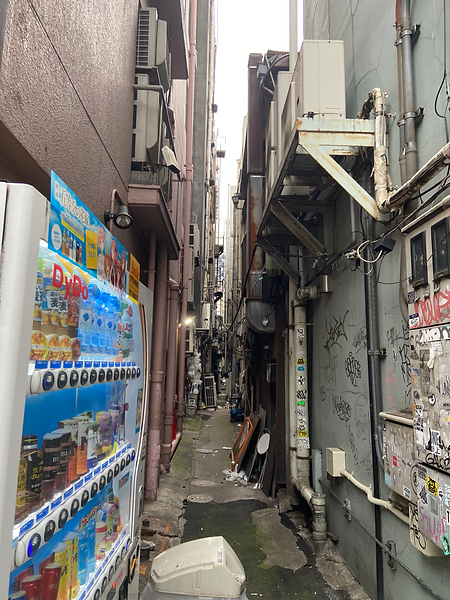
Surveillance Cameras
Effects of Surveillance Cameras
by Tokio
As previously mentioned, surveillance cameras have a profound effect on preventing crime. To be more precise, they are an effective security measure to prevent and reduce crime rates, as well as to detect criminals for investigation. Based on a survey conducted on criminals, 48% claim that they would not have committed the crime if they knew about the surveillance camera (Isnard, 2001). Similar impacts are seen in Kabukicho as well. Between 2001, the year 500 surveillance cameras were installed, and in 2016, recorded offenses in public spaces dropped from 634 to 325 (Abema, 2018). Furthermore, surveillance cameras also seem to impact catches who work for businesses, as they are more strictly regulated through the ‘Fu-ei law’ or the Act on Control and Improvement of Amusement Business. Compared to the catches and scouts in the main streets of Kabukicho, who engage in extralegal, gray zone activities, catches who work for the industry conduct their activities in less surveilled streets. In one case, a middle age man in the Nakamise-Dori, a smaller alley between Chuo and Sakura-Dori, approached and followed a pedestrian offering services at a soapland. Such cases are seldom seen in the well-surveilled areas like the Ichibangai, indicating activities that are more closely related to the law are less likely to occur at least directly under the eye of the cameras.

The number of observed crimes in public space of Kabukicho through 2001 and 2016.

Scout standing directly under the camera’s sight.
On the other hand, extralegal activity, gray zone activities that are governed by regulations but not covered by the law, continue regardless of the presence of surveillance cameras. Like the instance in the MOA 2nd Avenue, mentioned in the introduction, many catches and scouts go about with their business no matter the presence of surveillance cameras. Cameras do not stop other forms of extralegality, such as littering, loitering, and smoking, as Toyoko-kids sit directly underneath the cameras and engage in activities that are ‘prohibited’ in Toyoko Hiroba. Other than the gray zone activities that occur throughout the city, cameras also disregard stores that conduct intimate activities, such as those commonly seen in the Sakura-Dori. As previously mentioned, not many surveillance cameras are placed near these stores, which allows more customers to enter without considering any risks. Despite some services being illegal in Japan, these stores operate their business through various loopholes, which are commonly known and ignored. All of these extralegal activities and services in Kabukicho could be detected and caught if surveillance cameras are used strictly and placed disregarding the type of place. However, in reality, surveillance cameras are being ignored and the surveillance cameras are ignoring these problems as well. Why is this the case? First, extralegal activities are not violent crimes that keep many people away from Kabukicho. Hence, it is not necessary to strictly prohibit these actions. Next, and most importantly, catches, scouts, and services keep the businesses in Kabukicho running, keeping the money flow alive.
Although many of the neighborhood associations (kumi-ai) may not be supportive of the presence of these extralegal activities, as they could potentially scare off their customers, it is undeniable that if all of these activities are restricted, Kabukicho’s activities will stop operating. Furthermore, the extent to how much the money from Kabukicho impacts Shinjuku City and the government is uncertain; however, the reason why the cameras, even those managed by the police and the government are ineffective towards extralegality is the detrimental impact it will have on the economy of Kabukicho.
Other than its role to prevent and detect criminal activity, the presence of surveillance cameras itself creates a feeling of safety. This sense of safety decreases the people’s fear of crime, increasing the usage of the area (Isnard, 2001). Hence, the presence of cameras in Kabukicho increases the flow of people, contributing to the liveliness of the city. In reality, however, Kabukicho continues to be one of the most dangerous cities in Japan. Hence, the strong presence and a high number of surveillance cameras may ‘lull people into a false sense of security' (Isnard, 2001). Furthermore, surveillance cameras can also have a possibility to create danger, which is caused by displacement. Displacement occurs when areas near the surveillance camera become safer, but other places with fewer cameras or without any cameras become more dangerous, creating a ‘hot spot’ for criminal activity (Koskela, 2000). Compared to Kabukicho Itchome, Kabukicho Ni-Chome, mainly consisting of the love hotel district has fewer surveillance cameras, creating a displacement within Kabukicho. As expected, there are high numbers of theft reported in Kabukicho Ni-Chome. Also, as mentioned, Shinjuku Ni-Chome has fewer numbers of cameras as well, and most of them are covert cameras, which means there are very few cameras visible in the streets. During my time there, I observed a few suspicious men wandering around the street and was approached by them. Compared to the catches and scouts who would quickly walk away, these men would stick around, giving me a strong sense of discomfort, especially knowing there are fewer cameras around. In addition to the lack of surveillance cameras in areas of displacement, there also tends to be a lack of ‘natural surveillance’, consisting of street lights and the eyes of other people (Welsh et al., 2015). Natural surveillance is all over highly surveilled places, such as the bright Neon lights in Ichiban-Gai and the unstopping flow of people in the Chuo-Dori. In comparison, areas of displacement tend to be darker and lack other pedestrians, increasing the risks and fear.

Displacement is seen in narrow roads like these which are commonly found in Kabukicho.

Although safety is a concern, a false sense of security and displacement does not stop the flow of people into Kabukicho. However, too many cameras could impact the popularity of Kabukicho. Excessive usage of surveillance cameras makes the place less pleasant as it causes “the natural social life of public space” to end, causing the streets to be dead (Koskela, 2000). To prevent Kabukicho from losing its fascination, surveillance cameras are installed only in high-risk areas of violent crimes and less in other places. For instance, Toyoko hiroba is a popular area occupied mainly by teens and young adults. Although this area is known for underage drinking and other extralegal activity such as littering and loitering, there are only two surveillance cameras to be seen, both installed in front of stores and not necessarily faced toward the hiroba. Because the hiroba is not as heavily surveilled and activities are not strongly restricted, it can continue to be a ‘place’ for those who feel a sense of belonging there. The balance between surveillance cameras and ignorance towards gray-zone activities maintains the safety of the people while allowing users to attach a meaning to Kabukicho, making it a meaningful, attractive ‘place’ for each user of Kabukicho (Cresswell, 2011).
One of the two cameras in the To-yoko Hiroba.
Conclusion
Unquestionably, surveillance cameras have an effect on preventing violent crime from going on in the streets of Kabukicho. Nevertheless, they ‘slip up on’ grey zone activities and crimes, which are important aspects of what keeps Kabukicho a significant ‘place’ for its users. Like how privacy and surveillance were under debate when surveillance cameras were first introduced, it is visible that the safety, privacy, and most importantly the freedom to allow continue Kabukicho to be as ‘Kabukicho’ as possible were all important aspects that were concerned when installing surveillance cameras. Based on observations, it seems that surveillance cameras are used at the right balance as of now, which continues the activities, and most important the money flow going in this lively metropolitan city.
Sections
Surveillance Cameras
